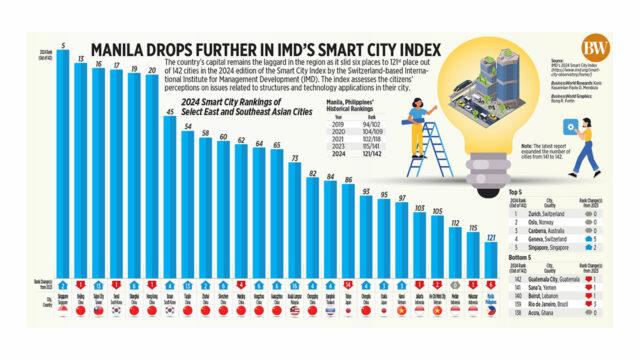By Kyle Aristophere T. Atienza, Reporter
PRESIDENT Ferdinand R. Marcos, Jr. on Tuesday condemned threats to Philippine sovereignty that he said were harming Filipinos, vowing to uphold a rule-based international order with the support of allies.
“Our nation remains confronted with novel challenges, in varying forms and degrees, but with the same existential impact,” he said in a speech as the country commemorated the sacrifices of Filipino soldiers during World War II, when Bataan province on the main island of Luzon fell to Japanese soldiers.
“Some portend clear and present threats to our sovereign rights, and in fact have already caused physical harm to our people,” he added.
Such present threats were “unacceptable, unjustifiable, and unjust,” he lamented, noting that nations should be having peaceful coexistence.
Mr. Marcos issued the remarks as the Philippines struggles to keep China at bay within its exclusive economic zone (EEZ) in the South China Sea.
China’s coast guard on March 23 fired water cannons at Philippine ships delivering food and other supplies to a Manila outpost at Second Thomas Shoal. A similar incident happened earlier in the same month.
Armed Forces of the Philippines Chief of Staff General Romeo Brawner, Jr. was on a similar resupply boat in December that a Chinese Coast Guard vessel fired water cannons at.
“On a much deeper level, the Fall of Bataan is not just a past event that we commemorate,” Mr. Marcos said. “It serves as a constant reminder of our singular purpose towards the future as one nation, supported by like-minded allies in this post-war, rules-based international order.”
The Philippine leader said his government has been “doubling efforts” to enhance the military’s operational capability, citing the need to procure the right equipment for them.
“I therefore task the Department of National Defense and the Armed Forces of the Philippines to assess and submit a report on the responsiveness of the current inventory of military supplies and equipment,” he added.
“These measures aim to show our unwavering support to our soldiers as they face new and growing challenges.”
Mr. Marcos, 66, has veered away from his predecessor’s pro-China policy, boosting the Philippines’ ties with the US and its allies in the region.
The Philippines held joint military drills with Japan and Australia within Manila’s exclusive economic zone in the South China Sea at the weekend.
Mr. Marcos has given the US access to four more military bases on top of the five existing sites under their 2014 Enhanced Defense Cooperation Agreement.
The two countries held their first Maritime Cooperative Activity within Philippine waters in November, and the third one in February.
The treaty allies are set to hold their annual Balikatan (shoulder-to-shoulder) exercises on Apr. 22 to May 18 where 5,000 Filipino soldiers and 11,000 US military personnel are expected to participate.
For the first time, it will be held beyond the Philippines’ 12-nautical-mile territorial waters, according to the Philippine military.
‘PEACE ZONE’
Also on Tuesday, a group of Filipino scientists urged the Philippine government to push the designation of the entire South China Sea as a marine protection area dedicated to mutual cooperation in line with international law.
The Philippines should lead efforts for a “regional agreement” that would make the entire waterway, including Manila’s exclusive economic zone, “a marine protected peace and biodiversity zone” that is free from any form of militarization, AGHAM said in a statement.
“It should be dedicated for research, fishing and mutual cooperation without undermining sovereignty,” it said.
It said studies conducted by Filipino scientists within the Philippines’ EEZ are “crucial in understanding biodiversity in the area, and assessing their conditions, which are essential for ensuring food security not only in the Philippines but in the whole region.”
AGHAM also opposed boosting military ties with the US, Japan and Australia, saying they “only heighten tensions and raise the risk of a potential military conflict.”
But the group said China has been “persistently bolstering” its military presence in the waterway “by occupying atolls and small islands, converting them into military bases.”
In March, China warned Manila to “be prepared to bear all potential consequences” if it “insists on going its own way,” adding it would not hesitate to pursue “more resolute actions.”
Filipino scientists have raised alarm over declining fish output within the Philippine EEZ in the waterway amid reports of man-made destruction of coral reefs and other marine features. They warned that fishes that depend on coral reefs could become extinct.
The Center for Strategic and International Studies earlier reported that China had destroyed at least 21,000 acres of coral reefs within the Philippine EEZ.
Another think tank, the Asia Maritime Transparency Initiative, has also attributed coral reef destruction in the waterway to Chinese activities such as dredging to build artificial islands, as well as clam harvesting.
In late March, AMTI said Second Thomas Shoal, Luconia Shoals, Scarborough Shoal, Vanguard Bank and Thitu Island were the five features most frequented by patrols of the Chinese Coast Guard last year.
“While China callously turns itself into an imperialist country who bullies and dominates its Asian neighbors by its military might, the Philippines should strongly counter by steadfastly asserting our sovereignty through diplomacy and using international solidarity,” AGHAM said.













